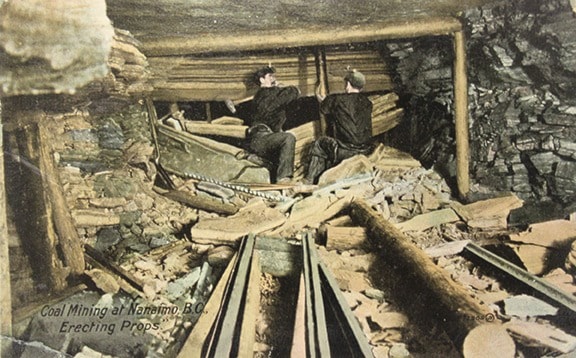His helper — irony of ironies — was the very F. Meyer who was supposed to have accompanied Hunter, and whose place poor Gregor had taken.
As if cave-ins, explosions, rock falls and poison gas weren’t enough, other hazards to life and limb awaited Vancouver Island’s coal miners of old.
When Andrew Hunter and George Gregor stepped into the cage of Nanaimo’s Douglas Pit, in May 1876, the last thing they expected was for engineer William Reid to forget to put the elevator in gear.
Just the men’s weight was sufficient to start the cage downward.
Unable even to slow their descent, Reid shouted a warning — as the luckless miners plummeted 300 feet straight down, where only two feet of water broke their fall.
In one of those unaccountable vagaries of fate, Hunter survived with no more injury that a severe shaking up and a broken ankle. When poor Gregor, 35, and formerly of Pennsylvania, was brought to the surface he was, as a newspaper reporter succinctly put it, stone dead. His only apparent injury was a wound over one eye.
Not surprisingly, engineer Reid was reported to be “greatly exercised” over his role in the tragedy, his first accident in 14 years of operating the hoist. Those who knew him said that Reid was “the steadiest and safest engineer in the country,” to the point of becoming a “proverb among the miners”.
Edward G. Prior, then an employee of the Vancouver Coal Co. a future mines inspector and a future provincial premier, testified at the inquest that he’d ordered Hunter and F. Meyer to undertake some repair work in the mine, but Meyer had been unavailable. Hence the luckless Gregor being sent in his place and, as it happened, to his death.
In fact, Prior had been about to enter the cage, too, but had been called away.
Minutes later, he hurried back upon being informed of the accident. Engineer Reid was crying and, putting his arms about Prior, said, “Oh, Mr. Prior, it is all my fault.”
“Nothing of the sort, Willie, it will be all right,” Prior said he replied, and allowed Reid to go home.
Questioned as to operating procedures, Prior reluctantly conceded that the accident wouldn’t have occurred if the elevator had been in gear rather than in neutral which meant that there was nothing really holding the cage in position once the men stepped into it.
Henry Bolton, miner, told how he’d volunteered to help bring the injured men out. His helper — irony of ironies — was the very F. Meyer who was supposed to have accompanied Hunter, and whose place poor Gregor had taken.
Gregor suffered no broken bones in the fall, his death having been caused by a puncture wound in the forehead which had penetrated the brain.
Jury foreman William Flewit, upon asking if it was not customary in the Old Country for hoist engines to have brakes, was informed that the Douglas Pit’s machinery had been installed just as it had arrived from its Scottish builders — without brakes.
A petition signed by almost 200 VCC employees “setting forth in strong terms” the confidence they had in engineer William Reid was presented to the jury.
Those six worthies, after several hours’ deliberation, ruled that George W. Gregor met his death through “an accident which...would probably have not occurred had the necessary appliance of a break [sic] to the drum...been supplied by the owners of the mine”.
There you have it: the mine’s owners were at fault for not having fitted the hoist engine with a brake.
Not a word about engineer Reid’s starring role in the tragic affair!
www.twpaterson.com
